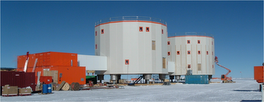Concordia Science #1 - AstroConcordia
 Seismology is not the only science programme being run at Concordia. In fact, seismology is only a small experiment compared to some of the others being run at the base. One of the larger scientific programs is AstroConcordia. Read on to find out more.
Seismology is not the only science programme being run at Concordia. In fact, seismology is only a small experiment compared to some of the others being run at the base. One of the larger scientific programs is AstroConcordia. Read on to find out more.
The AstroConcordia program, which is run by the Nice University Laboratory of Astrophysics, aims to qualify the Dome C site for astronomy. In order for a site to be good for astronomy, it must have clear skies for a good part of the year, but also a calm atmosphere, as atmospheric turbulence can perturb ground based observations.
The quality of a site can be measured by a number of experiments, many of which have been running at Concordia for two winters, now. Preliminary results have shown that the Dome C site is exceptional for astronomy. The climate at Concordia is extreme, so it is necessary to test the mechanical properties of all instruments to the enviromental conditions.
The Concordia base website lists the following astronomy experiments being currently run at the base:
DIMM (Differential Image Motion Monitor) and GSM (Generalized Seeing Monitor), which measure parameters of the atmospheric turbulence, in order to quantify the seeing quality of the site.
SSS (Single Star Scidar) measures the distribution of turbulence as a function of altitude.
MOSP measures the external scale of atmospheric turbulence by analyzing the deformations of images of the moon. The measurements obtained by this instrument complement those obtained by GSM.
PAIX is a camera that measures the photometric quality of the night sky. It is mounted on the same telescope as MOSP, but is used only during the nights with no moon.
SONICS determines the quality of low altitude turbulence, using sonic probes at 10, 20 and 30 m elevation to measure the wind speed in three dimensions.
SKY-CAM is a wide angle camera (120 degrees) that continuously observes the night sky in order to quantify cloud cover.
For more information, you should read the AstroConcordia web page on the Concordia site, and the following two International Polar Year Projects:
- AstroPoles: Astronomy from the Polar Plateaus,
- Stella Antarctica: Towards and international astronomical observatory at Dome C in Antarctica.
-----
Keep up to date with the latest developments at http://sismordia.blogspot.com




No comments:
Post a Comment